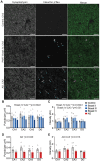Hippocampal synaptic alterations associated with tau pathology in primary age-related tauopathy
- PMID: 37595576
- PMCID: PMC10516464
- DOI: 10.1093/jnen/nlad064
Hippocampal synaptic alterations associated with tau pathology in primary age-related tauopathy
Abstract
Primary age-related tauopathy (PART) is characterized by aggregation of tau in the mesial temporal lobe in older individuals. High pathologic tau stage (Braak stage) or a high burden of hippocampal tau pathology has been associated with cognitive impairment in PART. However, the potential underlying mechanisms are not well understood. Cognitive impairment in many neurodegenerative diseases correlates with synaptic loss, raising the question of whether synaptic loss also occurs in PART. To address this, we investigated synaptic changes associated with tau Braak stage and high tau pathology burden in PART using synaptophysin and phospho-tau immunofluorescence. We compared 12 cases of definite PART with 6 controls and 6 Alzheimer disease cases. In this study, the hippocampal CA2 region showed loss of synaptophysin puncta and intensity in cases of PART with either a high stage (Braak IV) or a high burden of neuritic tau pathology. There was also loss of synaptophysin intensity in CA3 associated with a high stage or high burden of tau pathology. Loss of synaptophysin was present in Alzheimer disease, but the pattern appeared distinct. These novel findings suggest the presence of synaptic loss associated with either a high hippocampal tau burden or a Braak stage IV in PART.
Keywords: Aging; Neurodegeneration; Primary age-related tauopathy (PART); Synapses.
© The Author(s) 2023. Published by Oxford University Press on behalf of American Association of Neuropathologists, Inc. All rights reserved. For permissions, please email: journals.permissions@oup.com.
Conflict of interest statement
The authors have no duality or conflicts of interest to declare.
Figures



Update of
-
Hippocampal Synaptic Alterations Associated with Tau Pathology in Primary Age-Related Tauopathy.medRxiv [Preprint]. 2023 Jun 7:2023.02.22.23286323. doi: 10.1101/2023.02.22.23286323. medRxiv. 2023. Update in: J Neuropathol Exp Neurol. 2023 Sep 20;82(10):836-844. doi: 10.1093/jnen/nlad064. PMID: 36865237 Free PMC article. Updated. Preprint.
Similar articles
-
Hippocampal Synaptic Alterations Associated with Tau Pathology in Primary Age-Related Tauopathy.medRxiv [Preprint]. 2023 Jun 7:2023.02.22.23286323. doi: 10.1101/2023.02.22.23286323. medRxiv. 2023. Update in: J Neuropathol Exp Neurol. 2023 Sep 20;82(10):836-844. doi: 10.1093/jnen/nlad064. PMID: 36865237 Free PMC article. Updated. Preprint.
-
Asymmetry of Hippocampal Tau Pathology in Primary Age-Related Tauopathy and Alzheimer Disease.J Neuropathol Exp Neurol. 2021 Apr 16;80(5):436-445. doi: 10.1093/jnen/nlab032. J Neuropathol Exp Neurol. 2021. PMID: 33860327 Free PMC article.
-
Protein contributions to brain atrophy acceleration in Alzheimer's disease and primary age-related tauopathy.Brain. 2020 Dec 5;143(11):3463-3476. doi: 10.1093/brain/awaa299. Brain. 2020. PMID: 33150361 Free PMC article.
-
Regulatable transgenic mouse models of Alzheimer disease: onset, reversibility and spreading of Tau pathology.FEBS J. 2013 Sep;280(18):4371-81. doi: 10.1111/febs.12250. Epub 2013 Apr 22. FEBS J. 2013. PMID: 23517246 Review.
-
Genetic forms of tauopathies: inherited causes and implications of Alzheimer's disease-like TAU pathology in primary and secondary tauopathies.J Neurol. 2024 Jun;271(6):2992-3018. doi: 10.1007/s00415-024-12314-3. Epub 2024 Mar 30. J Neurol. 2024. PMID: 38554150 Free PMC article. Review.
Cited by
-
Cognitive symptoms progress with limbic-predominant age-related TDP-43 encephalopathy stage and co-occurrence with Alzheimer disease.J Neuropathol Exp Neurol. 2023 Dec 22;83(1):2-10. doi: 10.1093/jnen/nlad098. J Neuropathol Exp Neurol. 2023. PMID: 37966908 Free PMC article.
-
Transcriptional signatures of hippocampal tau pathology in primary age-related tauopathy and Alzheimer's disease.Cell Rep. 2025 Mar 25;44(3):115422. doi: 10.1016/j.celrep.2025.115422. Epub 2025 Mar 13. Cell Rep. 2025. PMID: 40085647 Free PMC article.
-
Spatial proteomics of hippocampal subfield-specific pathology in Alzheimer's disease and primary age-related tauopathy.Alzheimers Dement. 2024 Feb;20(2):783-797. doi: 10.1002/alz.13484. Epub 2023 Sep 30. Alzheimers Dement. 2024. PMID: 37777848 Free PMC article.
-
Effect of Small Extracellular Vesicles Produced by Mesenchymal Stem Cells on 5xFAD Mice Hippocampal Cultures.Int J Mol Sci. 2025 Apr 24;26(9):4026. doi: 10.3390/ijms26094026. Int J Mol Sci. 2025. PMID: 40362265 Free PMC article.
-
TDP-43 Is Associated with Subiculum and Cornu Ammonis 1 Hippocampal Subfield Atrophy in Primary Age-Related Tauopathy.J Alzheimers Dis. 2024;99(3):1023-1032. doi: 10.3233/JAD-240136. J Alzheimers Dis. 2024. PMID: 38728190 Free PMC article.
References
Publication types
MeSH terms
Substances
Grants and funding
LinkOut - more resources
Full Text Sources
Medical
Miscellaneous

